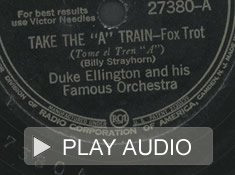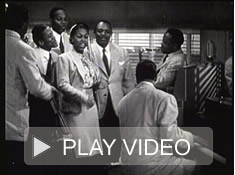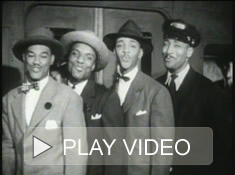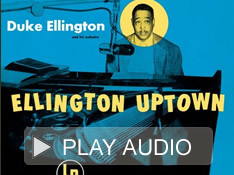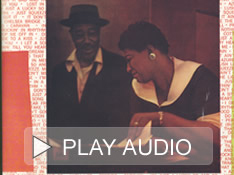

Take the "A" Train: Audio and Video
Select a versions of Take the "A" Train to hear audio or watch video of a specific version of the song.
Original RCA recording - February, 1941. (2:57)
Take the "A" Train is a showcase for trumpeter Ray Nance, making his first commercial recording with the Ellington orchestra after having joined the band in November 1940 to replace Cootie Williams. The band plays the first chorus, Nance plays a two-chorus solo, first on muted trumpet, and then on open (unmuted) trumpet. Nance's solo is so well conceived that it became an integral part the composition; later trumpet players in the band usually played the same solo.
Film clip from Reveille with Beverly – October, 1942. (3:20)
This film featured an array of World War II-era musical stars, including the Duke Ellington Orchestra. But Hollywood got it wrong: the setting here is a railroad train, while the lyrics refer to a New York City subway train. After the band plays the theme, vocalist Betty Roche sings a chorus, with call-and-response interplay by a vocal trio consisting of cornetist Rex Stewart, trumpeter Ray Nance, and baritone saxophonist Harry Carney. As Roche and Nance dance in the aisle, solos follow by Ellington, Junior Raglin on bass, and Ben Webster (unseen) on tenor saxophone.
Film clip by the Delta Rhythm Boys vocal group – 1941. (2:27)
The Delta Rhythm Boys were a popular vocal group of the 1940s and 1950s. With infectious joie de vivre, they sing the lyrics of "A" Train, then in the second chorus introduce their own special lyrics to the melody of Ray Nance's trumpet solo on Ellington’s now-famous recording. This film was made for World War II-era film jukeboxes called Soundies.
Extended vocal version with Betty Roche – June, 1952. (8:00)
This recording is a prime example of how Ellington and Strayhorn kept pieces fresh by re-imagining and re-orchestrating them. This extended arrangement turns the spotlight away from trumpeter Ray Nance, whose rendition was by now very familiar, to shine on a singer and a saxophonist. Ellington plays three choruses, then Betty Roche sings the melody and does two choruses of bebop-influenced scat-singing, sounding more modern than in her 1942 film version. There is a change in tempo, and tenor saxophonist Paul Gonsalves takes over for three final choruses. After one bluesy chorus, the band doubles its tempo, and the piece ends dramatically with a 23-second unaccompanied cadenza by Gonsalves.
Vocal by Ella Fitzgerald with the Ellington Orchestra - June 1957. (6:42)
Ella Fitzgerald Sings the Duke Ellington Song Book featured this striking new arrangement, by Billy Strayhorn, which opens playfully with a train-whistle imitation and Fitzgerald scatting. Fitzgerald sings the lyric, then does a chorus of scat-singing. Three choruses of trumpet soloing follow, featuring guest artist Dizzy Gillespie trading phrases with Clark Terry. Fitzgerald does a chorus of scat-singing and lyric-singing, recomposing the melody line.
Instrumental version for TV - January, 1962. (3:00)
This performance, made for a TV special titled Goodyear Jazz Concert: Duke Ellington, hews closely to Ellington's original recording, made 21 years earlier. The main difference is that in the fourth and final chorus, instead of the band playing more and more softly, Nance improvises a solo.
